Air Change Rates and IAQ
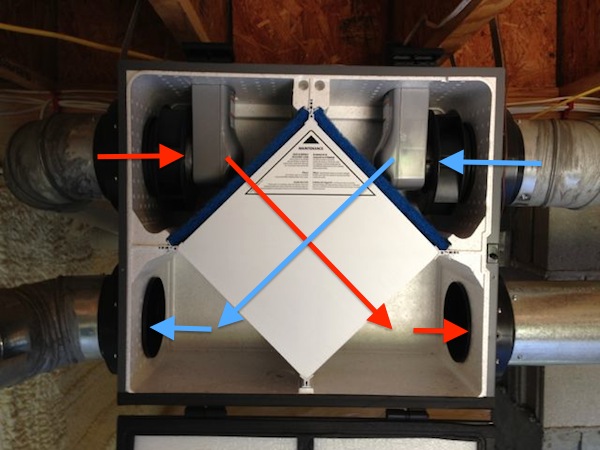
Let’s talk about one of my favorite subjects: air. Because of the global COVID-19 pandemic and the novel coronavirus (SARS-COV-2) that spreads it, the indoor air quality (IAQ) community—researchers, mediators, manufacturers, bloggers, groupies—is having a moment. This must be the first time in history that IAQ researchers have logged so many hours on television and been quoted so frequently in news articles. And they’re tweeting up a storm, too. And that brings me to the tweet by IAQ researcher Dustin Poppendieck that served as the impetus for this article:
That tweet was one of four in a short thread he put out earlier this week. His point was that the calculated air change rate is based on how much “new” air you put into a room, but that doesn’t mean you’re removing an equal amount of “old” air from the house. The difference is mixing. Some of the air removed will be the air you just put into the room, with the proportion of new-to-old air dependent on the amount of mixing that happens. And that got me thinking…
What Poppendieck said is important, but he really just scratched the surface of this topic. His tweet referred to a room, but what about larger areas, like a zone or a whole building? What kind of air are we talking about here? Air being recirculated through the heating and cooling system? Air infiltrating and exfiltrating through the building enclosure? Ventilating with outdoor air? And what do we need to know about mixing?
Mixing it up
Poppendieck’s point is that if you have a room full of air that has a certain concentration of pollutants, you probably don’t remove an equal amount of old air just by adding new air. Thus, you don’t remove as many pollutants as you might think. In his tweets, Poppendieck takes a kind of worst-case scenario, one which you get a lot of mixing and remove less of the old air pollutants. He gave as an example the introduction of new air at the rate of 6 air changes per hour (ACH). The other way to look at air changes is to flip it from air changes per hour to hours per air change. So, 6 air changes per hour means that it takes 1/6 hours per air change. At that rate, he said, instead of changing all the air in the room in 1/6 of an hour (10 minutes), it could take “up to 0.5 hours to remove 95%” of the old air. So, a lot of mixing means that it could take, in this case, about three times longer to change out most of the air.
But what if you get little to no mixing? You’d get most of the old air removed in about 10 minutes at an air change rate of 6 ACH. How could that happen? By putting the air in slowly and having the entry and exit points well separated in the room. The ASHRAE Handbook of Fundamentals has a great chapter all about ventilation and infiltration, and they call this type air movement displacement flow. (See diagram below, from chapter 16 of the ASHRAE Handbook of Fundamentals.)
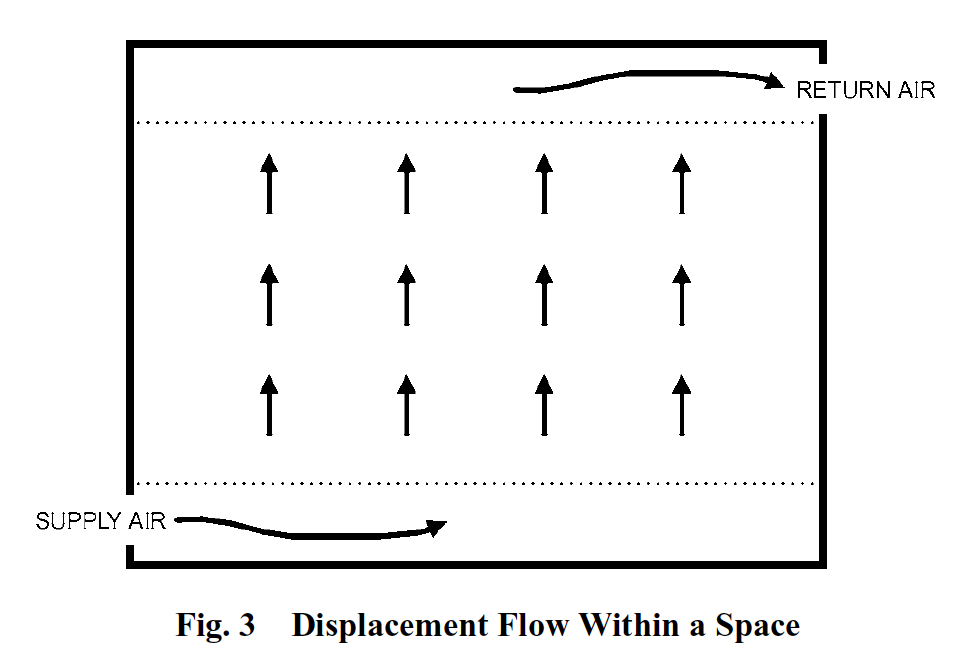
At the other end of the mixing spectrum is entrainment flow. The diagram below, also from the ASHRAE Handbook of Fundamentals, shows what that looks like.
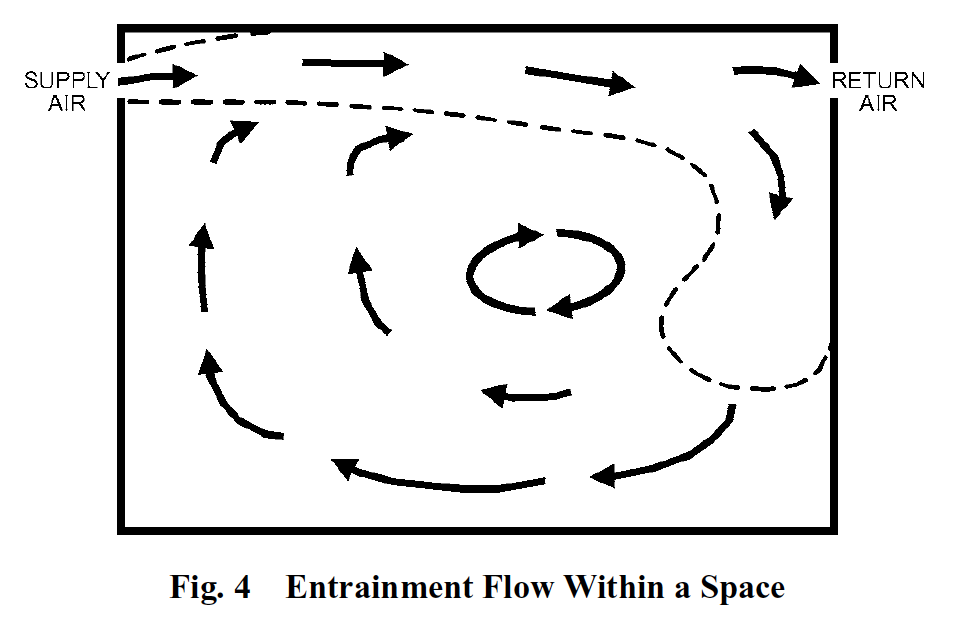
If you’re in the HVAC industry, the word “entrainment” may be familiar to you. ACCA’s Manual T on air distribution uses that word in discussing the mixing of air in a room. The old air in the room is induced, or entrained, to move with the new (primary) air. The result is that the new and old air get all mixed up in the room. When you have fans or people walking in a room, the air gets even more mixed up.
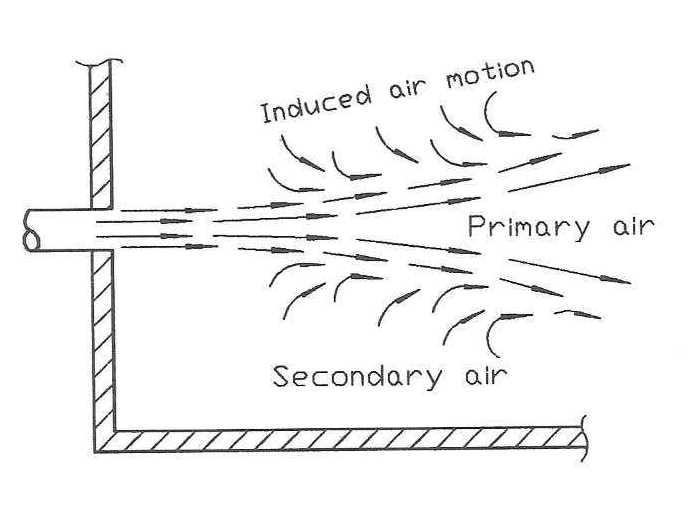
If your focus is removing pollutants from the room, it’s best to assume the new and old air get at least somewhat mixed up before exiting.
Where’d you get that air?
Although he didn’t mention it, I believe Poppendieck was talking about the new air being ventilation air from outdoors. But air can enter a room in different ways. Many of us live in homes with forced-air heating and cooling systems that recirculate air throughout the home. If you have good filtration integrated with such a system, that can help, too. I’ve written quite a bit about using filters rate at MERV-13 or higher, and they can reduce the pollutants in your indoor air significantly. Fibrous media air filters won’t remove pollutants in the gas phase, but they can capture the particulates, including the droplets and aerosols carrying the coronavirus.
Then there’s the air that infiltrates into the house from outdoors or from buffer spaces, like the garage, crawl space, and attic. Contrary to what some people still believe, a house does NOT need to breathe. Breathing dead possum from the crawl space or air sucked through a dead squirrel in the attic is not as good as straight outdoor air. The best thing to do is air seal the house as much as possible and rely on other ways to improve your indoor air quality.
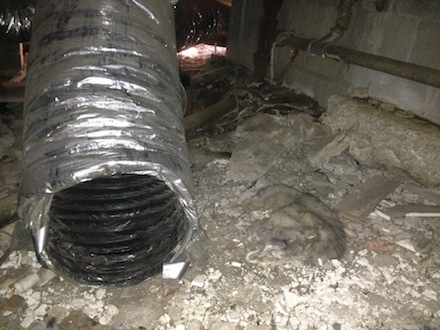
Mechanical whole-house ventilation systems help improve indoor air quality by introducing outdoor air into the house. If the coronavirus is the only pollutant you’re concerned with, all outdoor air is good air. But you should be concerned with more than just this one pollutant. In most homes, the majority of the small particulates that are most dangerous to health (PM2.5) comes from outdoors. During wildfires, there’s a whole heck of a lot of particulates in the outdoor air, so good filtration must be part of your IAQ strategy. Also, in some areas, you may need to pay attention to your outdoor air quality on a regular basis and pick the best times to introduce outdoor air.
Room, zone, building
The last issue here is scale. Poppendieck’s tweet focused on a room, which is the right scale for a quarantine room or a room where you might bring other people into your house for a while. But all the air in your house is connected, and that can help. If, for example, you set up a quarantine or entertainment room with an exhaust fan or exhaust vent for an energy or heat recovery ventilator (ERV or HRV) and your outdoor air is supplied to another part of the house, you’ll come close to having displacement flow. That means you’ll be removing relatively unmixed air that has a lot of the original pollutants in it.
Air flow through a building is a complex subject. If you’re a researcher, diving in and understanding that complexity is important. If you’re a homeowner, teacher, or building supervisor, what’s most important is to look for ways to increase the amount of ventilation in poorly ventilated spaces, clean the air with MERV-13 or higher filters, and block infiltration from garages, crawl spaces, attics, or other places that have worse air than is in the house already. You can also use portable air cleaners, like the Comparetto Cube, to help remove pollutants in a room.
David Byrne and the Talking Heads were ahead of their time musically, but did you know they were early advocates for good indoor air quality? Here’s what they had this to say in the song Air:
Air can hurt you too
Some people say not to worry about the air
Some people never had experience with…
So, pay attention. Changing the air in your house, office, or classroom is critical. But how quickly are you really removing the old air with all its pollutants? And what are you replacing it with? Ventilation, filtration, source control, and moisture control are your best options for good indoor air quality.
Some ‘a you people just about missed it!
Allison Bailes of Atlanta, Georgia, is a speaker, writer, building science consultant, and founder of Energy Vanguard. He is also the author of the Energy Vanguard Blog and is writing a book. You can follow him on Twitter at @EnergyVanguard.
Related Articles
Which Indoor Air Pollutants Matter Most?
Can Your HVAC System Filter Out Coronavirus?
How to Make a Good High-MERV Filter Even Better
NOTE: Comments are moderated. Your comment will not appear below until approved.
This Post Has 19 Comments
Comments are closed.

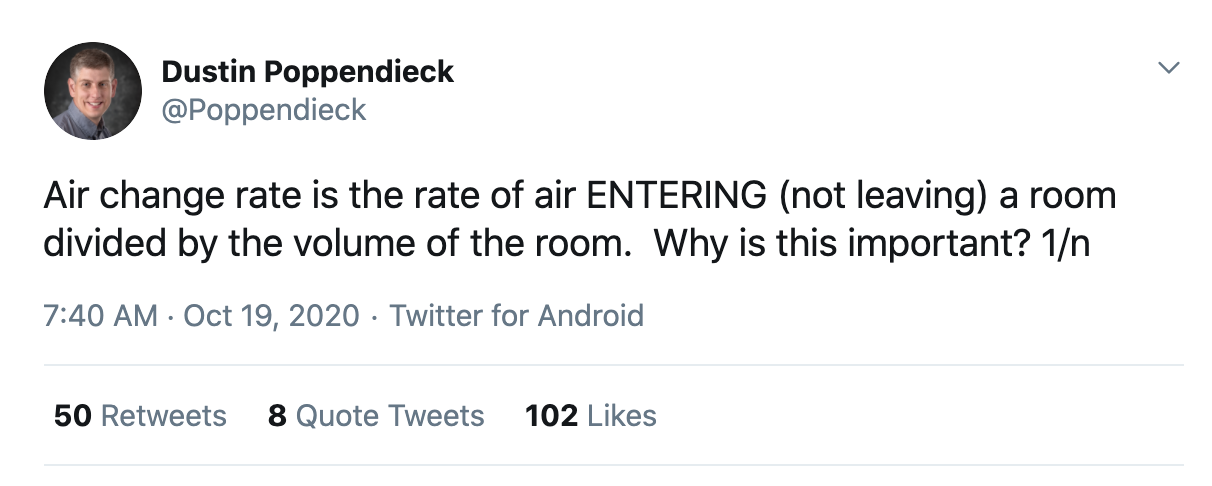
It is probably technically
It is probably technically correct that air change rate is the volume of air ENTERING the space divided by the space volume, but for all practical purposes, the amount of air LEAVING the space is equal to the amount of air ENTERING the space. Thus, this is a moot point. What is important is the type of ventilation that is needed. If you are after contaminant dilution, the source and amount of the supply air and its mixing in the space is important as described in this article. If you are after contaminant source removal (e.g., a range hood), the location and amount of exhaust air is important and mixing within the space is generally not desirable. In terms of ASHRAE Std. 62.2, exhaust-only ventilation is allowed for general dilution purposes because it correctly assumes that make-up supply air will naturally occur from the outdoors to replace the exhausted air. Unfortunately, it does not ensure that this air did not pick up contaminants from an attic, crawl space, garage, sewer drain, or adjacent dwelling unit first. Some people on the committee are trying to change this, especially for multi-family housing, but there is strong opposition to this.
Ah, but Roy, it’s not a moot
Ah, but Roy, it’s not a moot point. That was the whole message Poppendieck was trying to get across. Putting, say, 100 cfm of clean air into a room doesn’t mean you’re extracting 100 cfm of the original pollutant-laden air. Because of mixing, the pollutants are removed at a slower rate and the 100 cfm coming out includes some of the new clean air. In a classroom, office, or restaurant, the difference can be important if there’s someone in the room who’s contagious with COVID-19. Based on other things you wrote, I think you know this so I’m a bit confused why you said it’s a moot point.
Also, contaminant source removal can also happen with the heating & cooling system return (assuming good filtration) or an ERV return in a room. If the supply is in another room or all the way across the room, all or most of the air removed could be what I called old air in the article. That avoids the problems associated with exhaust-only ventilation, as long as there are good return air pathways between supply and return.
Allison, I will stick with my
Allison, I will stick with my statement. Define a space or zone anyway you want and the amount of air entering equals the amount of air leaving. It’s just conservation of mass. Mixing is important in terms of contaminant removal. Depending on where air enters or leaves relative to the contaminant source, mixing can be good or bad. As an example, the opposite of a well mixed space is one with displacement ventilation. Displacement ventilation is great if I am upstream of the sick person. It is terrible if I am downstream. If we have good mixing instead of displacement ventilation, I am just averaging the risk, which might be better since I probably don’t know who is sick–if I did, I wouldn’t be in the same space.
Roy, I agree with
Roy, I agree with conservation of mass, but there is a key word we are discussing here: change. Air introduction rate and air exfiltration rate are equal, but neither of them adequately describes change. Change means a qualitative difference- the air entering is different than the air leaving. Imagine entering air has blue smoke and room air has red smoke. What is the rate at which the room air will turn blue? Of course the answer depends on dilution, displacement, and circulation. Adding 100 cfm of blue smoke does not mean 100 cfm of red smoke is leaving (unless you have perfect displacement).
I do agree more with you than Allison on dilution though. Perfect displacement can only happen with perfect introduction- a wall of pin-size nozzles perfectly creating a displacement zone. But we have diffusers- made to mix the air for thermal comfort. Well mixed air will ultimately remove more pollutants, because displacement will be imperfect and leave dead zones that will retain all the red smoke. At least if it is well mixed, I know the rate of decrease and it will decrease evenly everywhere.
As usual, great topic. I am
As usual, great topic. I am smack in the middle of this with my houses as I usually get a blower-door number of .5 -.7 ACH50. Makeup air is a big deal. Your well-written article begs the question for me “what is the objective of make-up air?” Are we looking to totally replace the whole house air volume over and over again? A certain percentage? I have read that .35 ACH is an objective. But what I infer here is that may be way too low. How do we justify the cost of heating/cooling/dehumidifying air that we will be replacing over and over again. I use QFAM Air King makeup air units that provide a minimal 120 cfm to maintain a positive house, until a range hood or dryer increases the negative flow. They require additional makeup air sources. If we lack significant sources of pollutants except for human occupancy (CO2 and methane), what is reasonable? Your kind guidance would be welcomed.
Thomas, those are good
Thomas, those are good questions. The official objective of makeup air is to prevent negative pressure in the house from backdrafting combustion appliances. Here’s what the 2018 IRC says:
Where one or more gas, liquid or solid fuel-burning appliance that is neither direct-vent nor uses a mechanical draft venting system is located within a dwelling unit’s air barrier, each exhaust system capable of exhausting in excess of 400 cubic feet per minute (0.19 m3/s) shall be mechanically or passively provided with makeup air at a rate approximately equal to the exhaust air rate.
Another objective is to prevent the exhaust fans from pulling air from places like the garage, crawl space, attic, or other spaces where the air quality isn’t so good. The rate, as stated in the code, should be “approximately equal to the exhaust air rate.” Put in a 600 cfm range hood. You need ~600 cfm of makeup air.
Ventilation air and makeup air are two different things, although a lot of people do have trouble keeping them separate in their minds. Makeup air is needed only when the the >400 cfm exhaust fan is operating. Whole house ventilation is needed every day.
The 0.35 air changes per hour you refer to is from an old version of the ASHRAE residential ventilation standard. The current standard is based on floor area and number of bedrooms. The rate required for a dwelling unit is 3 cfm per 100 square feet of conditioned floor area plus 7.5 cfm per person, with the number of people calculated as the number of bedrooms plus one. You also get credit for the amount of infiltration if you do a blower door test, but with a house as tight as yours, that’s probably not going to reduce what you need from your ventilation system.
For normal conditions, that rate is fine. With COVID-19, the standard rate is probably not enough if there’s someone in the house who’s infected and contagious. In schools and other spaces, the rates need to be even higher.
Spend a few minutes reading
Spend a few minutes reading about the effect of high CO2 on sleep and cognitive performance and I suspect most will want better than “the worse you can legally build”. I’d also assure 15 CFM of fresh air/occupant to each closed door room.
I took a photo of my
I took a photo of my blackened HVAC filter after two of my wife’s smell purdy candles that you may be interested in using on indoor air pollution, how can I send it to you?
Got it, John. Thanks!
Got it, John. Thanks!
Something I’ve been saying
Something I’ve been saying since late March is that maybe we should’ve invoked the defense production act to churn out ERVs. Give every business and school a couple. This would drive the price down a whole bunch, and now it’s cheaper to improve IAQ and efficiency after the pandemic!
Alexander, that would have
Alexander, that would have been a good thing to do. Since we’re still going to be dealing with this problem for a while, maybe there’s a chance it could still happen.
What about changes in
What about changes in concentration of a particular pollutant? Wouldn’t the old adage “the solution to pollution is dilution” apply when additional fresh air is added to a room?
Wouldn’t this mixing effect
Wouldn’t this mixing effect make a case for the use of ceiling fans? In rooms with high activity and poor supply/return design, the ceiling fans would help circulate air throughout the room and mix new and old air. In previous articles, you’d lamented the overuse of ceiling fans in homes.
Homeowner of a 2002 home 2500sqft in Wisconsin that feels relatively leaky (original owner/builder had a penchant for going cheap on some of the things like windows that they could choose, and we couldn’t bear replacing all of them at once so just did the non-picture windows of one floor, with Andersen renewal) with a new HVAC 2 years ago. I got an SCD30 true CO2 sensor recently and have been basically horrified at what it’s telling me: when the family is in the great room, we can easily exceed 1300ppm, often above 1500, and basically never below 1000. It feels like we’ve got some effects (headache, etc) at those higher levels.
Trying to figure out the best way to increase ventilation: not too worried about covid because we’re staying completely isolated, nobody else is coming in. Opening opposite windows for cross draft does make a dent but isn’t ideal in the middle of winter. The only outdoor air supply in the HVAC is one of those old fresh air dampers into the return plenum with a weighted lever that’s supposed to be automatic but doesn’t work: I have it jammed open since I got the sensor, which helps. Have also turned on “circulate” mode on our fancy thermostat which says it will run the fan at least 1/3 the time, which helps. But, still getting the numbers above (was even worse before!)
Anything we can do besides get an erv or hrv? Not very interested in having service people in our home right now… Fan in the intake duct controlled by furnace fan combined with a servo on the damper? (Yes, I’m one of those electronics diy types, my sensor and dev board it’s connected to are from Adafruit) Fan speed change? (It’s an ECM aka DC brushless motor, two level gas forced air with central ac, 2500sqft) We’ve got a nice aprilaire cleaner in the system that I’ve put the Merv 16 filter in, so our particulates are awesome when not cooking: nearly unmeasurable counts and pm1.0/2.5/10.0 ratings of 0. (Yay more sensors) Glad it’s no worse for allergies sake (if you see no other humans, remaining respiratory trouble is allergies!), but the filter does nothing for co2 naturally…
Are there professionals that could maybe inspect and recommend for stuff like this via video call? I’m in the dangerous position of having enough sensors to know I’ve got a problem, but not enough knowledge to fix it without calling in another human being into my building envelope which is nope.
Thanks for your very informative blog! (Got a low level CO meter because of it, though wimped out and got the approx $70 Forensic Detectors one from Amazon. Sitting at zero, so pretty sure that’s not behind the headaches)
The first thing to understand is that CO2 sensors can be misleading due to a number of factors. The second is that how leaky the home is needs to be measured to understand what is happening. First I would check calibration on the CO2 sensor. What does it read outdoors (away from sunlight)? What does it read when the family is gone from the home for a few hours? It should read around 350-400 outdoors, maybe even a bit lower in rural areas with vegetation. It should drop significantly when out of the house.
2002 is an in-between time for home construction. It could be anywhere from 1980s standard to relatively tight. Windows might not be a good indicator. My recommendation would be to get an energy rater (HERS) to evaluate the tightness and quantify how many ACH happen naturally and how many need to be delivered by the HVAC.
Even in the best ventilated buildings, occupancy can overwhelm ventilation for short periods. Depending on how many people are in the room, even an ERV might be insufficient to keep CO2 low. If the problem is localized, circulating fans (ceiling or portable) will help with mixing and reduce levels.
Hope this helps!
Ryan, have you heard of air ionization? I believe the use of a Global Plasma Solutions (GPS) product may help you on multiple fronts as far as IAQ improvement in your home.
Simon, that is bad advice. Ionizers may create ozone. They create chemically active ions that can produce harmful byproducts. And their effectiveness is not proven. I’ll have an article on this topic next week.
Besides ionizers being a bad idea in general, they certainly wouldn’t help reduce Ryan’s carbon dioxide levels. The only way to do that effectively is by ventilating with outdoor air.
Hello guys, please correct me if I am wrong. My understanding is:
Ventilation deals with CO2 concentration. It has to be 100% outdoor air.
Air-change-rate deals with pollutants. It can be 100% properly filtered recirculated air.